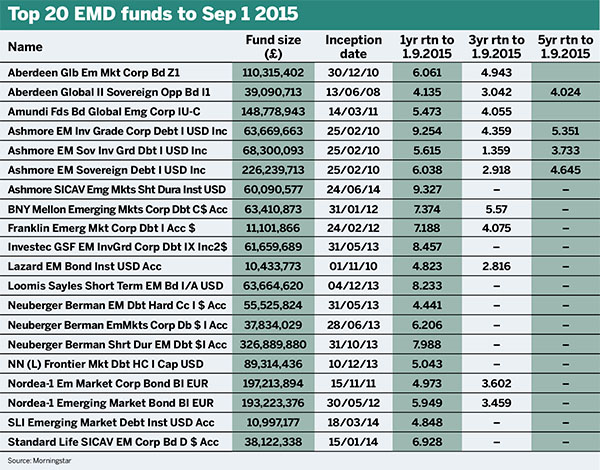EMD survey: In part one of a two-part analysis, we take a look at how emerging market debt has performed across the year and following a topsy-turvy summer across all markets.
However, short-term events can provide a useful opportunity to reassess current positions to judge whether the long view still holds.
The tumult surrounding the China stock market correction in the summer caused tremors across all global markets, which were most heavily felt in fellow Asian EM countries.
Such has been the scale of the fallout – which arguably is still falling out – that the ripples have crossed deeper into the monetary policy narratives of developed market nations such as the US and the UK.
The US Federal Reserve’s decision a fortnight ago to stay put on interest rates was in no small part down to the perceived fragility of the global economy since the China bubble burst.
In turn, the pervading wisdom on the trajectory of any interest rate rises has itself become another strong determinant of EM success.
Performance
The corporate and sovereign EM debt universe took a considerable hit during August’s lows.
The table shows gross returns of the top 20 EM funds for the year to September 1 2015. The lowest return in this group was 4.1 per cent, with the highest at 9.3 per cent.

However, just one month prior, the year-to-date figures to August 3 stood at 8.3 per cent and 12.3 per cent, respectively.
Pete Drewienkiewicz, head of manager research at consultancy Redington, says while the best route to EM debt is via a total return or absolute return-focused manager, even they have been tested over recent months.
“Many of these managers with previously robust track records have performed extremely poorly over the past 12-18 months,” he says. “It has been a very difficult period in EM generally.”
Between July and August, the MSCI EM equity index dropped around 10 per cent, compared with 3.5 per cent for JPMorgan’s Emerging Market Bond Index. However, this is unlikely to comfort EMD investors.
Lucinda Downing of consultancy Aon Hewitt’s global asset allocation team, says comparison of equity and bond returns is not particularly meaningful as EM equity and bond markets are both driven by the same economic fundamentals and are both viewed as risky asset classes.
“This means that equity/bond rotation is less of a factor in emerging market investment,” she says.
“There are also few institutional investors that vary their exposure across emerging asset classes as their investment decision is framed more as a developed/emerging market choice.”
Currency has clout
One thing all commentators we spoke to agree on is the significance of currency to EMD performance.
Rob Drijkoningen, portfolio manager and co-head of EMD at asset manager Neuberger Berman, says the strength of the US dollar, resulting from the expectation of monetary tightening, played a significant role in denting returns in the year to end-August.
But he says returns in euros were also down, at -5.6% on a year to date basis and -8.3% on a one-year trailing basis.
“The 2014 full-year return was positive in euro terms as a result of the euro weakening against the US dollar,” he says.
“The weak growth momentum relative to the upturn in developed markets and idiosyncratic challenges in major emerging countries like China, Russia and Brazil that were too large to ignore, more recently weighed on local currency returns.”
But there were pockets of better performance within the hard currency areas of the asset class. Mike Conelius, portfolio manager of T Rowe Price’s EM bond fund, points to the divergence of hard currency and local currency assets.
“Hard currency assets, particularly emerging markets corporate debt, generated solid returns through the first half of 2015 relative to the fixed income opportunity set, while the local currency bond sector has lagged considerably,” he says.
Brett Diment, head of EMD at Aberdeen Asset Management, agrees. He says: “It has been local currency sovereign debt which has really suffered, down 12.3 per cent due to the poor performance of emerging market currencies.”
But Aon’s Downing says returns in local terms have actually been positive over the past 12 months, “reflecting that EM weakness has been predominantly all about emerging currency”.
She adds: “Local EMD yields have picked up over the last six months, but the high level of yields have more than offset this move over the past 12 months to result in positive local returns.”
Downing says, in contrast, US dollar EMD indices have returned close to zero in dollar terms over the past year.
T Rowe Price’s Conelius says hard currency bonds do not carry the foreign exchange risks seen in the EM local bond or equity market, so it can be a less volatile way to access the strong growth potential.
He adds: “Most government issuers in the local currency market hold investment-grade ratings, solid sovereign fundamentals, and attractive real yields, but the FX component can be a large driver of your overall return so security selection and managing FX risk is critical.”
Redington’s Drewienkiewicz says given the weakness in local currencies over the past year and a half, the choices investors make around this area can make a huge difference.
“That said,” he adds, “perhaps the biggest difference in outcomes will have been driven by whether managers are benchmark-focused or not.
“Some talented unconstrained managers with the ability to short and access frontier markets have managed to ride out the volatility with some success, but benchmark-focused managers have generally struggled.”
Sovereign versus corp
There are also divergences in performance between sovereign and corporate debt. Aberdeen’s Diment paints the picture with the end-August one-year returns of sovereign bonds versus corporate bonds.
The JPMorgan EMBI Global Diversified index, which represents sovereign bonds, returned 1.24 per cent, while its corporate bond counterpart outperformed, returning 2.05 per cent, he says.
Monetary policy
In terms of future short-term performance, Conelius says while the Fed is still an important variable to keep a watching brief on, China probably carries the largest impact in terms of systemic market importance.
“The abrupt devaluation seen in August was disappointing in terms of policymaker transparency, and pointed to weaker growth than maybe the market was anticipating,” he says.
“But long-term, China will be able to continue to transition their economy into a more sustainable, consumption-led model.”
Naturally the EMD managers believe these divergences coupled with the wider sell-off will present investors such as pension funds with opportunities.














